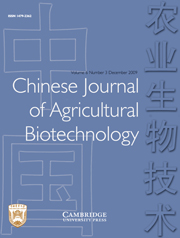Article contents
Classification of wheat PPO genes and effect of non-synonymous cSNP on kernel PPO activity
Published online by Cambridge University Press: 27 June 2008
Abstract
Polyphenol oxidase (PPO) activity is highly related to the undesirable browning of wheat-based end products. In this study, wheat PPO sequences (mRNA) were searched/BLASTed in the NCBI database and aligned using DNAMAN software. The results showed that wheat PPO genes could be divided into two clusters (I and II) and that three genes (‘i’) of cluster II seemed not to be located on chromosomes 2A and 2D. Ninety-four single nucleotide polymorphisms (SNPs) were detected between two haplotypes of the PPO gene on chromosome 2D. Eighty of these were found in the coding region (coding (c) SNPs) and 36 were non-synonymous cSNPs, which could affect the PPO amino acid sequence. Primers (STS-H) were designed at some non-synonymous cSNPs sites and were used to investigate the correlations between allelic variants and PPO activity of seeds – a total of 130 common wheat varieties were evaluated in 2 years. The results showed that STS-H could amplify a 460 bp DNA fragment in most cultivars with high PPO activity, while no PCR product was detected in most cultivars with low PPO activity. To improve the selection efficiency of a single dominance molecular marker, the multiplex polymerase chain reaction (PCR) system of STS-H and STS01 markers was also studied, based on the complementary between them.
Information
- Type
- Research Papers
- Information
- Copyright
- Copyright © China Agricultural University 2008
Footnotes
First published in Journal of Agricultural Biotechnology 2007, 15(6): 970–975
References
- 2
- Cited by

